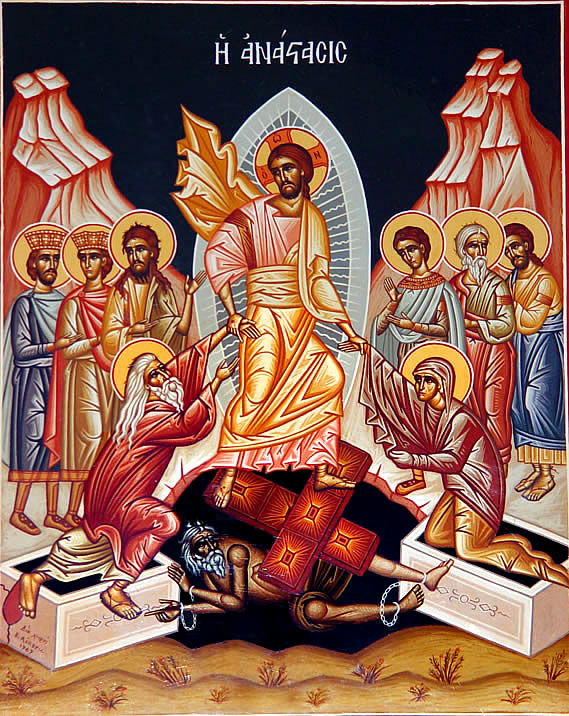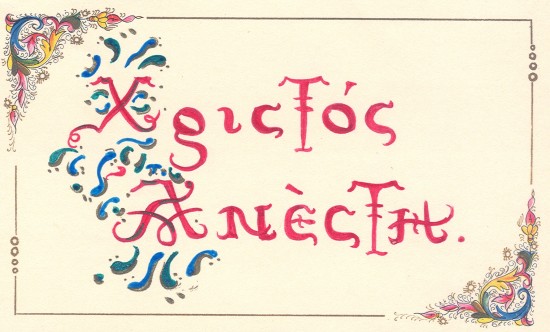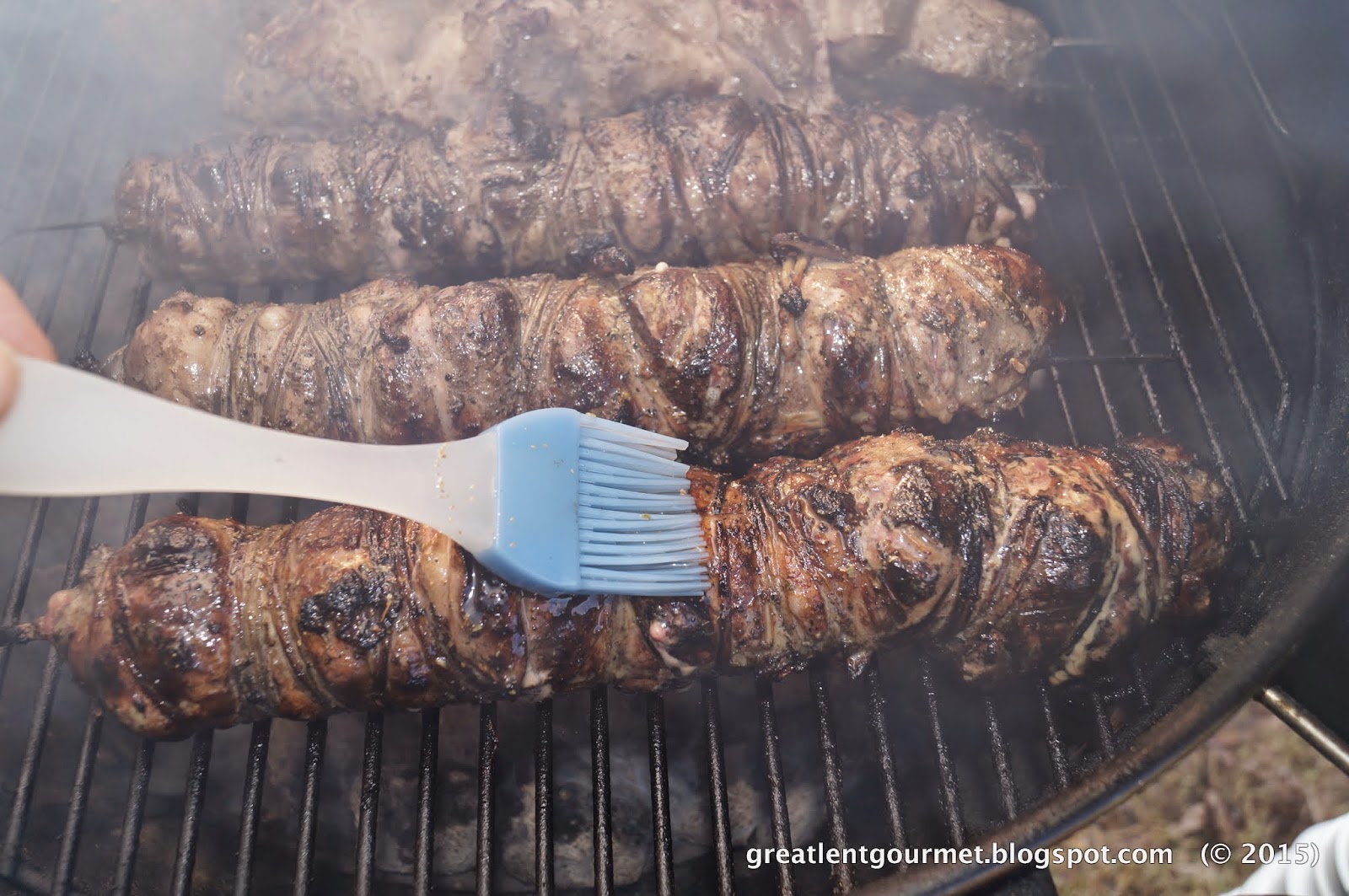 |
| Source of image: http://stgeorge.ia.goarch.org/Holy%20Week%20Pages/html/pascha.htm |

Christ Is Risen! Xristos Anesti! Let us celebrate the day!
Today, we are enjoying the fruits of our labour from yesterday. We are putting on the grill the hand made sausage-like treats that we prepared yesterday for you. Yes, today is the day to break the fast, celebrate Christ, and eat lamb -- and in this case, lamb by-products.
Yesterday we assembled, seasoned, and rolled the kokoretsi and put it away for us to cook today. We attended church, greeted friends and family, and now, we can leisurely break our fast. Today, you will not need many special things to finish the kokoretsi. You will need a grill (or oven) of your own choice (we chose to use a charcoal grill) and you will have to make the most ubiquitous Greek accompaniment for grilling: ladorigani sauce (salt, ground black pepper, oil, lemon, oregano sauce). Now, for the next step…
For this recipe you will need the following:
Oil (we normally prefer olive oil but today we decided to use canola oil)
Lemon Juice
Oregano
Ground black Pepper
Salt
We are not providing amounts of each ingredient, because the amount needed will change for each dish you use the ladorigani. Let's just say that if you start with one cup of oil, add to that 1/2 cup lemon juice, 1 TBSP oregano, 1 teaspoon pepper, and salt to taste. The other thing that we can tell you is that the ratio of oil to lemon juice is approximately 2 to 1; that means if you use 2 cups of oil, you will want to use about 1 cup of lemon juice, then, adjust the seasonings accordingly, and then, adjust to your taste. We like lemony and a little salty, so for us, we may add a little more of each, and leave the amount of oregano the same.
Whisk the ingredients well so that everything is well combined, and so the oil and lemon form a thin emulsion and looks like it thickened a bit. Now, get a brush and get ready to work.
We started the charcoal and heated up the grill. You want the charcoal white to cook the kokoretsi quickly, so it does not burn. Remember, the offal is wrapped with caul fat, and that layer of fat is covered by intestines. Well, that layer of caul fat, even though it is wrapped by intestines, may still drip fat onto the fire, which likely will create flames. So, if the coals are very hot, then the outside will cook quickly, drip off the fat, create flames, and then calm down so the kokoretsi can cook through the centre. But, since we know this will happen, we thought we could add another layer of flavour to the barbecue process, so we added Applewood Wood Chips; we know that this is not exactly traditional in Greek cooking but decided to try it for the first time as we often use wood chips to enhance the flavour of our barbecues. When you use wood chips, you have to soak them for at least 30 minutes before using in order to prevent burning, as well as to impart the smokiness. Soak them in water and then, add them to the hot charcoal. The wood chips will make some smoke which will add a nice layer of flavour on the meat.
Put the skewers on the grill and cook on the first side about 5 minutes. You should do this with the lid closed so the wood chips can do their thing for the flavour. This five minutes is long enough to sear the outside of the meat, get a little extra flavour, and make you start craving the kokoretsi. We turned the meat every five minutes at first, closing the lid each time. Then, as the intense heat burned away (as did the wood chips), we maintained a steadier temperature with the coals, and that's when we turned the skewers every 10-15 minutes.
Here is where the ladorigani comes into use. Each time you turn the kokoretsi, brush it with ladorigani. Turn, brush, turn, brush, turn, brush. You want to brush as quickly as you can with the oil so you cover the entire side of the skewered meat. After each brushing, allow that side to cook for a few more minutes and turn.
How do you know when the kokoretsi is cooked and done? That's the difficult part. You can tell it is cooked through the centre by the way the meat feels. The meat should be firm with very little give. You can also see the outside layer of fat will mostly disappear, and you will see that the wrapping of intestines looked like they are no longer clear, but a nice charred colour covering a white lining. Lastly, you will see how the rolled kokoretsi has shrunken and looks tighter than it did raw. It will look like a smaller sausage-like roll. But, the best way to know if the kokoretsi is done is to cut it open.
Once the kokoretsi is done cooking, move it from the grill to a pan or a cutting board. Slide the kokoretsi off the skewer before cutting it. Typically, one or two pieces will break away from the log. You will be able to see the colour inside is a pinkish-brownish-grey, the same colour that cooked liver is. If there is a lot of dark pink showing, the kokoretsi is not fully cooked.
Brush the final cooked kokoretsi with a little more ladorigani. Now, you can either use scissors to cut the chunks of meat and cut through the wrapping, or you can use a serrated knife and slice pieces as you would any cooked sausage. Once you have cut the kokoretsi, you can brush a little more ladorigani on it and serve. Serve this warm with a cold glass of ouzo, or a small glass of wine. The flavours go together well and may allow you to relax enough where you can close your eyes and picture being in Greece for this Pascha. Kali Orexi and Kalo Pascha.
For the fourth consecutive year we have successfully concluded a Great Lent with various ideas for all those who are challenged with the thought of "But what do we serve when we can't think of anything Lenten to prepare?" In the process, we have prepared a variety of new foods and drinks which we have experienced for the first time ever as well as other foods and drinks which we eat and drink on a regular basis.
We are pleased that many thousands of visitors have visited our blog each week of this year's Great Lent from dozens and dozens of countries around the world. In our shared journey of this year's Great Lent, we hope that you have found some of our entries helpful, nutritious and tasty. We apologize to those whose ideas we could not implement this year because of time or material constraints; we promise you that, God willing, we will complete these entries as soon as we are able to next year.
Until then, Christos Anesti! Χριστός Ανέστη! Christ is risen!
Belarusian – Хрыстос уваскрос! Сапраўды ўваскрос! (Chrystos uvaskros! Sapraŭdy ŭvaskros!
Bulgarian – Христос възкресе! or (Church Slavonic): Христос воскресе!
Croatian – Krist uskrsnu!
Czech – Kristus vstal z mrtvých!
Macedonian (Slavic Macedonian)-
Traditional (as per Church Slavonic) – Христос воскресе!
Vernacular – Христос воскресна!
Polish – Chrystus zmartwychwstał!
Russian – Христос воскрес!
Rusyn – Хрістос воскрес!
Serbian – Христос васкрсе! or Христос Воскресе!
Slovak – Kristus vstal z mŕtvych! the Slovak of eastern religions use Church Slavonic version: Christos voskrese!
Ukrainian – Христос воскрес!
Baltic languages
Latvian Kristus (ir) augšāmcēlies!
Lithuanian – Kristus prisikėlė!
Celtic languages
Goidelic languages
Old Irish – Asréracht Críst!
Irish – Tá Críost éirithe!
Manx – Taw Creest Ereen!
Scottish – Tha Crìosd air èiridh!
Brythonic languages
Breton – Dassoret eo Krist!
Cornish – Thew Creest dassorez!
Welsh – Atgyfododd Crist!
Austronesian languages: Malayo-Polynesian
Carolinian – Lios a melau sefal!
Chamorro – La'la'i i Kristo!
Fijian – Na Karisito tucake tale!
Filipino – Si Kristo ay nabuhay!
Hawaiian – Ua ala aʻe nei ʻo Kristo!
Indonesian – Kristus telah bangkit!
Kapampangan – Y Cristo sinubli yang mebie!
Malagasy – Nitsangana tamin'ny maty i Kristy!
Eskimo–Aleut languages
Aleut – Kristus aq ungwektaq!
Yupik languages – Xris-tusaq Ung-uixtuq!
Japanese – ハリストス復活!
Korean – 그리스도께서 부활하셨네!
Aleut – Kristus aq ungwektaq!
Yupik languages – Xris-tusaq Ung-uixtuq!
Japanese – ハリストス復活!
Korean – 그리스도께서 부활하셨네!
Na-Dené languages
Athabaskan languages
Navajo – Christ daaztsą́ą́dę́ę́ʼ náádiidzáá.
Tlingit – Xristos Kuxwoo-digoot!
Athabaskan languages
Navajo – Christ daaztsą́ą́dę́ę́ʼ náádiidzáá.
Tlingit – Xristos Kuxwoo-digoot!
Niger–Congo languages
Ganda Kristo Ajukkide!
Swahili – Kristo Amefufukka!
Gikuyu – Kristo ni muriuku!
Quechuan Languages
Quechua – Cristo causarimpunña!
Afro-Asiatic languages
Semitic languages
Arabic (standard) – المسيح قام! حقا قام!
Aramaic languages
Syriac – Mshiḥa qām!
Neo-Syriac – Mshikha qimlih!
Turoyo-Syriac – Mshiḥo qāyem!
Ethiopian languages
Tigrigna – Christos tensiou!
Amharic – Kristos Tenestwal!
Hebrew (modern) – המשיח קם!
Maltese – Kristu qam! or Kristu qam mill-mewt!
Egyptian
Coptic – Pikhristos Aftonf!
Sino-Tibetan languages
Mandarin – 基督復活了
Northwest Caucasian languages
Abkhazian - Kyrsa Dybzaheit!
Kartvelian languages
Georgian – ქრისტე აღსდგა!
Uralic languages
Estonian – Kristus on üles tõusnud!
Finnish – Kristus nousi kuolleista!
Hungarian – Krisztus feltámadt!
Source of these sources (with minor editing): http://en.wikipedia.org/wiki/Paschal_greeting












No comments:
Post a Comment